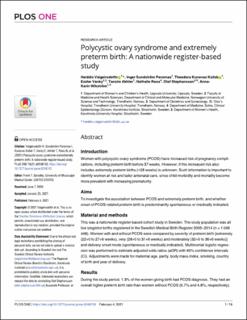| dc.contributor.author | Valgeirsdottir, Heiddis | |
| dc.contributor.author | Poromaa, Inger Sundström | |
| dc.contributor.author | Kallak, Theodora Kunovac | |
| dc.contributor.author | Vanky, Eszter | |
| dc.contributor.author | Akhter, Tansim | |
| dc.contributor.author | Roos, Nathalie | |
| dc.contributor.author | Stephansson, Olof | |
| dc.contributor.author | Wikström, Anna-Karin | |
| dc.date.accessioned | 2021-06-04T07:55:41Z | |
| dc.date.available | 2021-06-04T07:55:41Z | |
| dc.date.created | 2021-05-25T12:55:10Z | |
| dc.date.issued | 2021 | |
| dc.identifier.citation | PLOS ONE. 2021, 16 (2), 1-16. | en_US |
| dc.identifier.issn | 1932-6203 | |
| dc.identifier.uri | https://hdl.handle.net/11250/2757628 | |
| dc.description.abstract | Women with polycystic ovary syndrome (PCOS) have increased risk of pregnancy complications, including preterm birth before 37 weeks. However, if this increased risk also includes extremely preterm births (<28 weeks) is unknown. Such information is important to identify women at risk and tailor antenatal care, since child morbidity and mortality become more prevalent with increasing prematurity. Aims To investigate the association between PCOS and extremely preterm birth, and whether onset of PCOS-related preterm birth is predominantly spontaneous or medically indicated. Material and methods This was a nationwide register-based cohort study in Sweden. The study population was all live singleton births registered in the Swedish Medical Birth Register 2005–2014 (n = 1 046 448). Women with and without PCOS were compared by severity of preterm birth [extremely (22+0 to 27+6 weeks), very (28+0 to 31+6 weeks) and moderately (32+0 to 36+6 weeks)] and delivery onset mode (spontaneous or medically indicated). Multinomial logistic regression was performed to estimate adjusted odds ratios (aOR) with 95% confidence intervals (CI). Adjustments were made for maternal age, parity, body mass index, smoking, country of birth and year of delivery. Results During the study period, 1.3% of the women giving birth had PCOS diagnosis. They had an overall higher preterm birth rate than women without PCOS (6.7% and 4.8%, respectively). Women with PCOS had increased odds of preterm birth of all severities, with the highest odds for extremely preterm birth (aOR 2.3; 95% CI 1.7–3.0), particularly of spontaneous onset (aOR 2.7; 95% CI 2.0–3.6). Conclusions Women with PCOS had more than a two-fold increased risk of extremely preterm birth with spontaneous onset than women without such diagnosis. This can be important in antenatal risk assessment of preterm birth in women with PCOS. Future research is warranted to investigate the biological mechanisms behind preterm birth in women with PCOS. | en_US |
| dc.language.iso | eng | en_US |
| dc.publisher | PLOS | en_US |
| dc.rights | Navngivelse 4.0 Internasjonal | * |
| dc.rights.uri | http://creativecommons.org/licenses/by/4.0/deed.no | * |
| dc.title | Polycystic ovary syndrome and extremely preterm birth: A nationwide register-based study | en_US |
| dc.type | Peer reviewed | en_US |
| dc.type | Journal article | en_US |
| dc.description.version | publishedVersion | en_US |
| dc.source.pagenumber | 1-16 | en_US |
| dc.source.volume | 16 | en_US |
| dc.source.journal | PLOS ONE | en_US |
| dc.source.issue | 2 | en_US |
| dc.identifier.doi | 10.1371/journal.pone.0246743 | |
| dc.identifier.cristin | 1911696 | |
| dc.description.localcode | Copyright: © 2021 Valgeirsdottir et al. This is an open access article distributed under the terms of the Creative Commons Attribution License, which permits unrestricted use, distribution, and reproduction in any medium, provided the original author and source are credited. | en_US |
| dc.source.articlenumber | e0246743 | en_US |
| cristin.ispublished | true | |
| cristin.fulltext | original | |
| cristin.qualitycode | 1 | |

